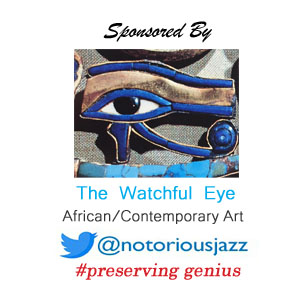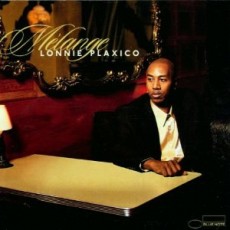
Daily Dose Of Jazz…
Lonnie Plaxico was born on September 4, 1960 in Chicago, Illinois and started playing the bass at age twelve. He turned professional at 14 playing both double bass and bass guitar. His first recording was with his family’s band, and by the time he was twenty he had moved to New York City, where he had stints playing with Chet Baker, Dexter Gordon, Sonny Stitt, Junior Cook and Hank Jones.
In 1978 he won the Louis Armstrong Jazz Award but first came to public attention through his work with the Wynton Marsalis group in 1982. Lonnie’s first regular attachment was with Art Blakey’s Jazz Messengers from 1983–1986, with whom he recorded twelve albums. At the end of his work relationship with Blakey he joined Jack DeJohnette’s Special Edition, and stayed with them until 1993.
Plaxico held the musical director and featured bassist position for Cassandra Wilson for fifteen years and has performed and recorded with a wide range of artists, including David Murray, Alice Coltrane, Stanley Turrentine, Andrew Hill, Abbey Lincoln, Joe Sample, Dizzy Gillespie, Bill Cosby, Lonnie Liston Smith, Barbara Dennerlein, Helen Sung and Ravi Coltrane among others.
Bassist Lonnie Plaxico has thirteen albums to his credit as a leader and continues to perform and record.
More Posts: bass
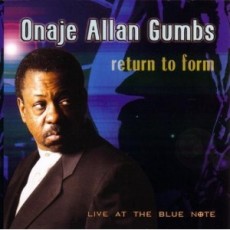
Daily Dose Of Jazz…
Onaje Allan Gumbs was born Allan Bentley Gumbs on September 3, 1949 in Harlem, New York but grew up in St. Albans, Queens. Starting to play piano at age 7, Henry Mancini was one of his earliest and greatest influences, hearing Peter Gunn and Mr. Lucky themes on television. He later studied at the Music and Art High School in Manhattan and was mentored by Erskine Tate Alum Leroy Kirkland.
During this time, he was playing in a Latin band, a big band, playing piano duets and listening to records made by Motown and Blue Note, developing an interest in R&B in conjunction with the straight-ahead jazz of Horace Silver, Dizzy Gillespie, Lalo Schifrin, Gil Evans, Miles Davis, McCoy Tyner and John Coltrane. He went on to study classical piano, composition, arranging and graduated with a degree in Education at the State University of New York at Fredonia in upstate New York.
In 1971, Leroy Kirkland introduced Onaje to guitarist Kenny Burrell and a subsequent gig led him to play with Larry Ridley and the Thad Jones/Mel Lewis Orchestra. He would join jazz ensemble Natural Essence that included Thelonious Monk Jr. In 1972he went to work with Norman Connors as an arranger on the Dark of Light album and contributed keyboards on the albums Love From the Sun, Saturday Night Special, You Are My Starship, Invitation and Mr. C.
Toward the late 1970s, Onaje spent two years working in Woody Shaw’s band as pianist, arranger, and occasional composer, in which the group won the Down Beat Reader’s Poll for Best Jazz Group and for Best Jazz Album in 1978 for Rosewood. His first solo piano project was simply titled Onaje and was followed by venturing into R&B and subsequently ending up on the smooth jazz charts and rotations for nearly 20 years with his composition “Quiet Passion”.
In 2003, Onaje return to straight-ahead with his release of the live album Return to Form, and garnering critical acclaim the next year with a project on his own label, Ejano, titled Remember Their Innocence. These were followed with Sack Full of Dreams before his stroke in 2010 but by year end had recorded and release Just Like Yesterday in Japan, with all signs of a stroke vanished. His sideman work has included stints with Buster Williams, Cecil McBee, and Betty Carter and most recently with Avery Sharpe on the 2012 album Sojourner Truth: Ain’t I A Woman.
He has received the Min-on-Art Award, has his song Dare To Dream chosen by Panasonic as the theme for their 10th anniversary celebration of Kid Witness News, composed, arranged and performed the original score for the Showtime film, Override and was nominated for an NAACP Image Award.
Suffering a stroke in 2010 he was able to return to music two weeks later. In 2015 he was hospitalized again for two weeks but made a full recovery and returned to composing and performance. Pianist, composer, arranger and bandleader Onaje Allen Gumbs passed away at 70 on April 6, 2020.
More Posts: piano
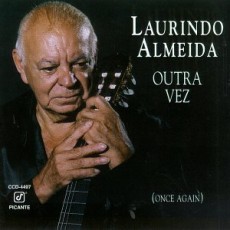
Daily Dose Of Jazz…
Laurindo Almeida was born Laurindo Jose de Araujo Almeida Nobrega Neto was born in the village of Prainha, Brazil on September 2, 1917. A self-taught guitarist, during his teenage years, he moved to São Paulo, worked as a radio artist, staff arranger and nightclub performer. At 19, he worked his way to Europe playing guitar in a cruise ship orchestra. While in Paris, he attended a performance at the Hot Club by Stephane Grappelli and Django Reinhardt, who became a lifelong artistic inspiration.
Returning to Brazil, Laurindo composed, performed and became known for playing classical Spanish and popular guitar. He moved to the United States in 1947 when one of his songs “Johnny Peddler” became a hit record by the Andrew Sisters. Once in Los Angeles, Almeida immediately went to work in film studio orchestras.
Almeida was first introduced to the jazz public as a featured guitarist with the Stan Kenton band in the late 1940s during the height of its success. His recording career enjoyed auspicious early success with the 1953 recordings now called Brazilliance No. 1 and No. 2 that was widely regarded as “landmark” recordings. Almeida and Shank’s combination of Brazilian and jazz rhythms in which Almeida coined the term “samba-jazz”. He would go on to have a classical solo recording career with Capitol Records beginning in 1954, winning a Grammy at the first awards ceremony.
Almeida won five career Grammys, toured, recorded and performed with the Modern Jazz Quartet, Charlie Byrd, Baden Powell, Stan Getz, Herbie Mann, Larry Coryell, Ray Brown, Shelly Manne and Jeff Hamilton to name a few. In addition he performed on more than 800 motion picture and television soundtracks such as The High Chaparral, Peter Gunn, Funny Girl, The Godfather and Unforgiven. He has been inducted into Fanfare’s Classical Recording Hall of Fame, received the Latin American & Caribbean Cultural Society Award and was awarded the “Comendador da Ordem do Rio Branco” by the Brazilian government.
Guitarist, composer and educator Laurindo Almeida was taught, recorded and performed until the week before passing away on July 26, 1995 at age 77 in Van Nuys, California.
More Posts: guitar
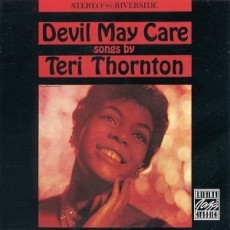
Daily Dose Of Jazz…
Teri Thornton was born Shirley Enid Avery on September 1, 1934 in Detroit, Michigan. Encouraged by her mother to study classical music, as a teenager she turned to jazz, singing and playing piano. Thornton first performed in local Detroit clubs in the 1950s but her debut as a professional took place at the Ebony Club in Cleveland, Ohio. She moved to Chicago and worked with Cannonball Adderley and Johnny Griffin. Her debut release of “Devil May Care” in 1961 for Riverside brought her national attention, with and a subsequent move to New York City where she established herself on the jazz and club scene.
Scoring her biggest hit with the theme to the television show Naked City “Somewhere In The Night” in 1963, she would next appear on the Ed Sullivan Show, get a recording contract from Columbia Records and receive a personal stamp of approval from Ella Fitzgerald as her favorite singer. Thornton also found work during this period singing for television ads and recording for several different labels.
By the late Sixties, Teri faded from public view, due to poor managers, alcohol and drugs. She moved to Los Angeles and it wasn’t until 1979 that she reemerged singing in small piano bars. It was decades later that she was discovered to have been singing on various song poem records in Los Angeles on the Preview label as “Teri Summers.”
Teri moved back to New York in 1983 and once again started performing on the club circuit. In 1998 she fully revived her career after a surprise win at the Thelonious Monk Institute of Jazz Vocal Competition. Thornton signed with Verve Records, releasing I’ll Be Easy to Find. Fame short-lived however, diagnosed with bladder cancer, jazz vocalist Teri Thornton passed away of the disease on May 2, 2000 in Englewood, New Jersey.
More Posts: vocal
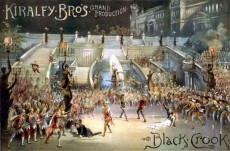
From Broadway To 52nd Street
Though no jazz standards came out of the musical, The Black Crook took the stage on September 12, 1866 and shocked, outraged and totally delighted American audiences. It was the first long running musical hit with a record 475 performances. Though often at odds with the Puritan morality that underwrote the founding of this nation, a new totally American art form, the Broadway musical, was born.
The Story: Set in 1600 in the Harz Mountains of Germany where evil, wealthy Count Wolfenstein seeks to marry the lovely village girl, Amina. With the help of Amina’s scheming foster mother Barbara, the Count arranges for Amina’s fiancé, Rodolphe, an impoverished artist, to fall into the hands of Hertzog, an ancient, crook-backed master of black magic. Hertzog has made a pact with the Devil (Zamiel, “The Arch Fiend”): he can live forever if he provides Zamiel with a fresh soul every New Year’s Eve. As Rodolphe is led to this horrible fate, he escapes, discovers a buried treasure, and saves a dove. The dove magically turns out to be Stalacta, Fairy Queen of the Golden Realm, who is pretending to be a bird. The grateful Queen rescues Rodolphe by bringing him to fairyland and then reuniting him with his beloved Amina. The Count is defeated, demons drag the evil Hertzog into hell, and Rodolphe and Amina live happily ever after.
Broadway History: The bastion of artistic collaboration, Broadway is the quintessential stage experience that marks the pinnacle of excellence between writer, composer, lyricist, director, choreographer, dancer and actor; thus very often creating a magical event that astonishes, amazes and delights the patron. Synonymously, 52nd Street was the mecca for interpretation of a new genre of music that emanated from the souls of black folks. It was jazz and the district symbolized greatness and brought together the creativity and individual voice of the masters with those who aspired to gain membership into this elite society of players.
Broadway and 52nd Street, where the avant-garde and art starved minions of high-society went to be entertained, are not only streets. They evolved into contractual classifications, industries, traditions and states of mind. They both became adventures into the depth of bawdiness, art and culture. A theatre or nightclub – devoid of clientele – was home to gypsies or musicians who practiced and rehearsed for hours, weeks, months and even years for that one opening night of lights where a star was often born. Whether the musical review lauded the performance or bespoke the incredulity of its author and/or performers, a select few songs garnered perpetual encores by living on in the voice of the jazz musician or vocalist who recognized the beauty of the melody that helped moved the musical story.
The Broadway musical is purely an American art form. While many consider 1927’s Showboat as the first great book musical, the use of drama, dance and music in one production all happened quite by accident and over sixty years earlier. In 1866, a Parisian ballet troupe was imported to perform at the Academy of Music. The theatre burned to the ground before the show could be staged, stranding the performers and financially draining the show’s producers. They, in turn, went to another impresario, William Wheatley – the manager of Niblo’s Garden, located on Broadway near Prince Street – who was preparing a melodrama called “The Black Crook”. Wheatley decided to turn The Black Crook into a musical extravaganza and for the first time ever on September 12th, audiences saw a drama, were entertained by an orchestra and saw a hundred gypsies kicking up their heels.
Sponsored By
www.whatissuitetabu.com



